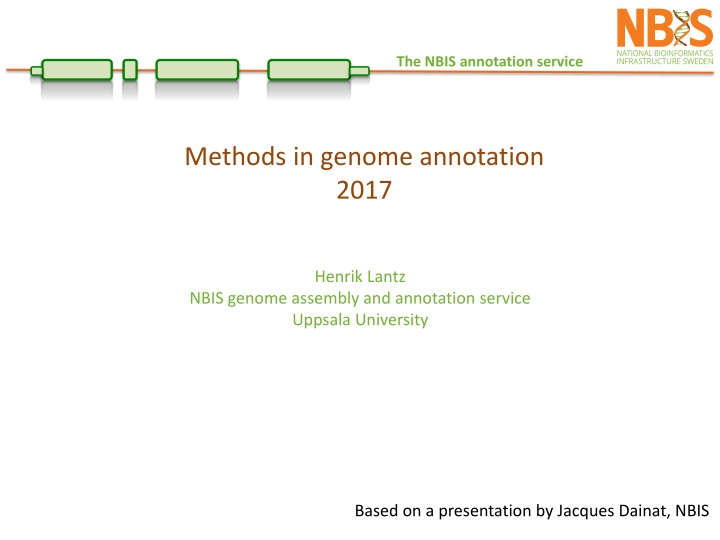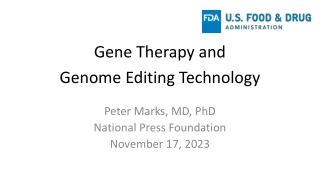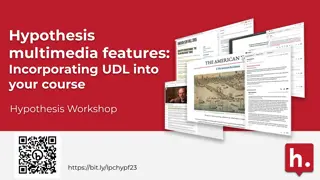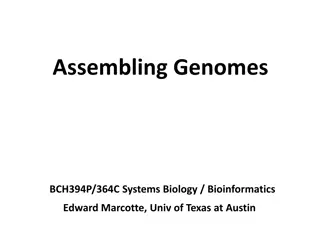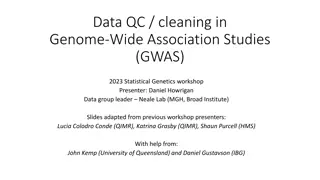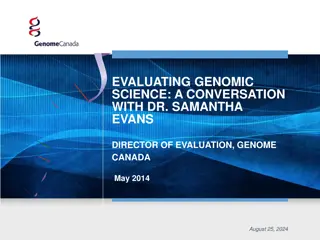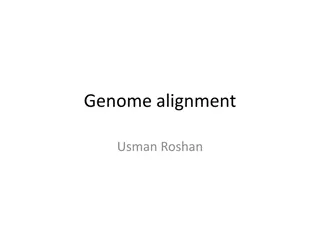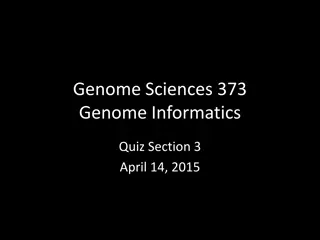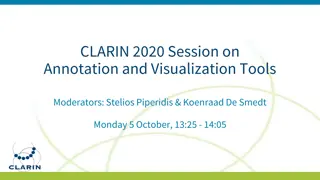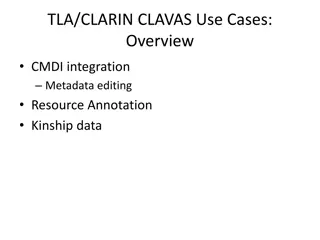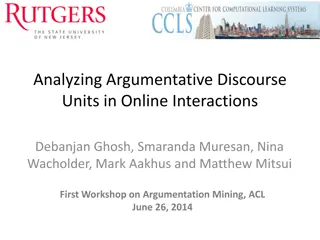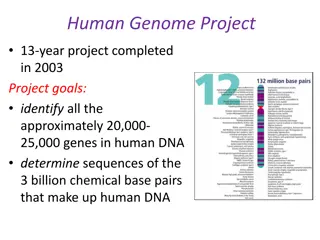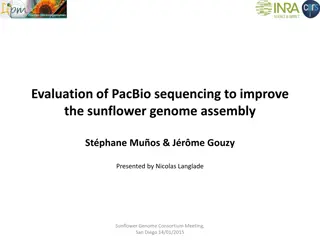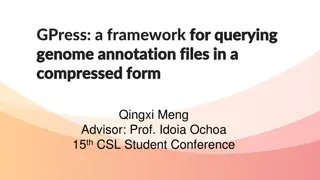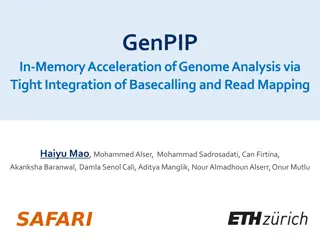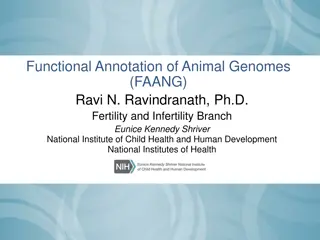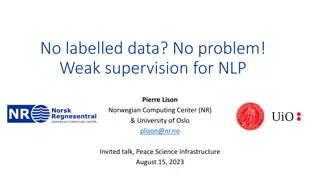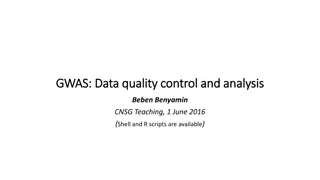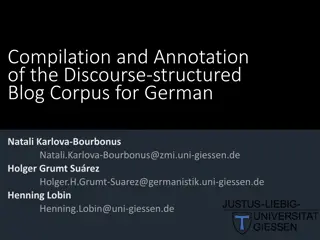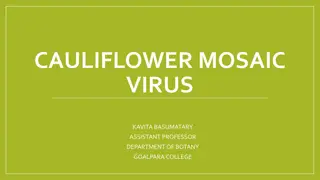Methods in Genome Annotation Service 2017: Approaches and Tools
This content delves into the methods and approaches used in genome annotation services, focusing on eukaryotes. It covers different annotation approaches such as similarity-based methods, ab initio prediction, hybrid approaches, comparative gene finders, and more. The lecture discusses popular tools like MAKER2 and Augustus for gene annotation. Various image objects illustrate the concepts presented in the lecture.
Download Presentation

Please find below an Image/Link to download the presentation.
The content on the website is provided AS IS for your information and personal use only. It may not be sold, licensed, or shared on other websites without obtaining consent from the author.If you encounter any issues during the download, it is possible that the publisher has removed the file from their server.
You are allowed to download the files provided on this website for personal or commercial use, subject to the condition that they are used lawfully. All files are the property of their respective owners.
The content on the website is provided AS IS for your information and personal use only. It may not be sold, licensed, or shared on other websites without obtaining consent from the author.
E N D
Presentation Transcript
The NBIS annotation service Methods in genome annotation 2017 Henrik Lantz NBIS genome assembly and annotation service Uppsala University Based on a presentation by Jacques Dainat, NBIS
The NBIS annotation service This lecture will focus on eukaryotes 1. Introduction - Understanding gene annotation 2. The different annotation approaches 3. Our method of choice: MAKER2 4. Check an annotation 5. Closing remarks
The NBIS annotation service 1. Introduction
Introduction The NBIS annotation service The different approaches Similarity-based methods : These use similarity to annotated sequences like proteins, cDNAs, or ESTs Ab initio prediction : Likelihood based methods Hybrid approaches : Ab initio tools with the ability to integrate external evidence/hints Comparative (homology) based gene finders : These align genomic sequences from different species and use the alignments to guide the gene predictions Chooser, combiner approaches : These combine gene predictions of other gene finders Pipelines : These combine multiple approaches
Introduction The NBIS annotation service The different approaches Similarity-based methods : These use similarity to annotated sequences like proteins, cDNAs, or ESTs Ab initio prediction: Likelihood based methods Hybrid approaches : Ab initio tools with the ability to integrate external evidence/hints Comparative (homology) based gene finders : These align genomic sequences from different species and use the alignments to guide the gene predictions Chooser, combiner approaches : These combine gene predictions of other gene finders Pipelines : These combine multiple approaches
The NBIS annotation service 2) The different annotation approaches 2.1) Ab-initio annotation tools intrinsic approach
Ab initio method The NBIS annotation service Uses likelihoods to find the most likely gene models Easy to use! augustus --species=chicken contig.fa > augustus_chicken.gff
Ab initio method The NBIS annotation service method based on gene content : (statistical properties of protein-coding sequence ) and on signal detection: Promoter ORF Start codon Splice site (Donor and acceptor) Stop codon Poly(A) tail CpG islands codon usage hexamer usage GC content compositional bias between codon positions nucleotide periodicity exon/intron size => Ab initio tools will combine this information through different Probabilistic models: HMM, GHMM, WAM, etc. These models need to be created if not already existing for your organism => training!
Ab initio method The NBIS annotation service Training ab-initio gene-finders Some gene-finders train themselves, others need a separate training procedure Around 1000 already known genes are usually needed to train the gene-finder These known genes can be inferred from aligned transcripts or proteins The quality of the gene-finder results hugely relies on the quality of the training! A fungal genome Fungi Plants
Assessing quality The NBIS annotation service Assess the quality of an annotation: TN TN FN FP TN FN TP FN TP REALITY PREDICTION Sensitivity is the proportion of true predictions compared to the total number of correct genes (including missed predictions) TP Sn + Specificity is the proportion of true predictions among all predicted genes (including incorrectly predicted ones) TP Sp= = TP+FP TP FN Ab Initio methods can approach 100% sensitivity, however as the sensitivity increases, accuracy suffers as a result of increased false positives.
Ab initio method The NBIS annotation service Popular tools: SNAP Works ok, easy to train, not as good as others especially on longer intron genomes. Augustus Works great, hard to train (but getting better). Supported by MAKER GeneMark-ES Self training, no hints, buggy, not good for fragmented genomes or long introns (Best suited for Fungi). FGENESH Works great, costs money even for training. http://weatherby.genetics.utah.edu/MAKER/wiki/index.php/MAKER_Tutorial GlimmerHMM (Eukaryote) GenScan Gnomon (NCBI)
Ab initio method The NBIS annotation service Strengths : Fast and easy means to identify genes Annotate unknown genes Exhaustive annotation Need no external evidence Limits : No UTR* No alternatively spliced transcripts* Over prediction (exons or genes) Training needed to perform well in terra incognita Split single gene into multiple predictions Fused with neighboring genes Less accurate than homology based method: - Exon boundaries - Splicing sites Hybrid method
The NBIS annotation service 2) The different annotation approaches 2.2) Hybrid approaches from the beginning
Hybrid method The NBIS annotation service Hybrid (evidence-drivable gene predictors) approaches incorporate hints in the form of EST alignments or protein profiles to increase the accuracy of the gene prediction.
Hybrid method The NBIS annotation service Hybrid (evidence-drivable gene predictors) approaches incorporate hints in the form of EST alignments or protein profiles to increase the accuracy of the gene prediction. GenomeScan Blast hit used as extra guide Augustus 16 types of hints accepted (gff): start, stop, tss, tts, ass, dss, exonpart, exon, intronpart, intron, CDSpart, CDS, UTRpart, UTR, irpart, nonexonpart. GeneMark-ET EST-based evidence hints GeneMark-EP Protein-based evidence hints SNAP Accepts EST and protein-based evidence hints. Gnomon Uses EST and protein alignments to guide gene prediction and add UTRs FGENESH+ Best suited for plant EuGene* Any kind of evidence hints. Hard to configure (best suited for plant) Self training !
Hybrid method The NBIS annotation service Strength : High accuracy Limits : - Extra computation to generate alignments - heterogeneous sequence quality : Incomplete, Error during transcriptome assembly Contamination Sequence missing Orientation error
Hybrid method The NBIS annotation service The BRAKER1 gene finding pipeline: BRAKER1: Unsupervised RNA-Seq-Based Genome Annotation with GeneMark-ET and AUGUSTUS Katharina J. Hoff et al. Bioinformatics (2016) 32 (5): 767-769. doi: 10.1093/bioinformatics/btv661 BRAKER1 was more accurate than MAKER2 when it is using RNA-Seq as sole source for training and prediction. BRAKER1 does not require pre-trained parameters or a separate expert-prepared training step.
The NBIS annotation service 2) The different annotation approaches 2.3) Chooser / combiner
Introduction The NBIS annotation service Overview Annotation = combining different lines of evidence into gene models Evidence: ESTs / Transcripts Proteins Ab-initio prediction Combining
Chooser / combiner The NBIS annotation service Use battery of gene finders and evidence (EST, RNAseq, protein) alignments and: Tool Consensus based chooser Evidence based chooser weight of different sources Comment A) select the prediction whose structure best represents the consensus JIGSAW X B) choose the best possible set of exons and combine them in a gene model EVM User can set the expected evidence error rate manually or/and learn from a training set Evidencemodeler X X X Evigan Unsupervised learning method X X Ipred Does not require any a priori knowledge Can also combine only evidences to create a gene model X Strength => Theyimprove on the underlying gene prediction models
The NBIS annotation service 2) The different annotation approaches 2.4) Gene annotation pipelines (The ultimate step) Align evidence, add UTRs and more
Annotation pipeline The NBIS annotation service PASA Produces evidence-driven consensus gene models - minimalist pipeline () + good for detecting isoforms + biologically relevant predictions =>using Ab initio tools and combined with EVM it does a pretty good job ! - PASA + Ab initio + EVM not automatized NCBI pipeline Evidence + ab initio (Gnomon), repeat masking, gene naming, data formatting, miRNAs, tRNAs - Not released by NCBI Ensembl Evidence based only ( comparative + homology ) MAKER2 Evidence based and/or ab initio
The NBIS annotation service 2) The different annotation approaches 2.5) Annotation of other genome features
Other genome features The NBIS annotation service Feature type DB associated Tool example approach ncRNA Rfam infernal HMM + CM tRNA Sprinzl database tRNAscan-SE CM + WMA snoRNA snoscan HMM + SCFG miRNA miRBase Splign sequence alignment miR-PREFeR (for plant) Based on expression patterns Repeats Repbase, Dfam repeatMasker HMM, blast Pseudogenes pseudopipe homology-based (blast)
The NBIS annotation service 3) Gene annotation pipelines (The ultimate step) 3) MAKER2
MAKER2 The NBIS annotation service MAKER developed as an easy-to-use alternative to other pipelines - can be used pure evidence-based, pure ab initio, or evidence-driven (on the fly) ab initio. - add UTR when ESTs are supplied. - Evidence based chooser : select post processed gene model which is most consistent with evidence (protein / EST / RNAseq) Advantages over competing solutions: Easy to use and to configure Almost unlimited parallelism built-in (limited by data and hardware) Largely independent from the underlying system it is run on Everything is run through one command, no manual combining of data/outputs Follows common standards, produces GMOD compliant output Annotation Edit Distance (AED) metric for improved quality control Provides a mechanism to train and retrain ab-initio gene predictors Annotations can be updated by re-launching Maker with new evidence But how does Maker work exactly?
MAKER2 The NBIS annotation service Step 1: Raw compute phase RepeatMasking Nucleotide repeats Transposons/viral proteins Soft-masking Hard-masking ATGCGTTTGacgtttaataattggGCATAGCCCT ATGCGTTTGNNNNNNNNNNGCATAGCCCT Masked genome
MAKER2 The NBIS annotation service Existing annotation pipelines MAKER2 Step 1: Raw compute phase Masked genome Blastn Blastx Proteins ESTs
MAKER2 The NBIS annotation service Step 2: Filter and cluster alignments Filtering is based on rules defined in the Maker configuration for a given project Example: EST alignment 80% coverage and 85% identity Default settings sensible for most projects, but can be changed!
MAKER2 The NBIS annotation service Step 2: Filter and cluster alignments Clustering groups evidence-alignments into loci
MAKER2 The NBIS annotation service Step 2: Filter and cluster alignments Problematic data can complicate clustering Needs to be fixed by => using clean data
MAKER2 The NBIS annotation service Step 2: Filter and cluster alignments Clustering groups evidence alignments into loci Amount of data in any given cluster is then collapsed to remove redundancy Threshold for the collapsing is also user-definable
MAKER2 The NBIS annotation service Existing annotation pipelines MAKER2 Step 2: Filter and cluster alignments Clustering groups evidence alignments into loci Amount of data in any given cluster is then collapsed to remove redundancy Threshold for the collapsing is also user-definable Performed for all lines of evidence
MAKER2 The NBIS annotation service Step 3: Polishing alignments Blast-based alignments are only approximations, need to be refined
MAKER2 The NBIS annotation service Step 3: Polishing alignments Blast-based alignments are only approximations, need to be refined Exonerate is used to create splice-aware alignments
MAKER2 The NBIS annotation service Step 4: Synthesis Synthesis refers to the extraction of information to generate evidence for annotations Done by identifying genomic regions overlapping with sequence features
MAKER2 The NBIS annotation service Step 4: Synthesis
MAKER2 The NBIS annotation service Step 4: Synthesis...and ab-initio gene finding Evidence alignments provide support for the identification of gene loci Ab-initio predictions can enhance these signals and fill gaps with no evidence
MAKER2 The NBIS annotation service Step 4: Synthesis...and ab-initio gene finding Ab-intio predictions can be improved when evidence is provided (hints) Help refine and calibrate a computational inference for a given locus
MAKER2 The NBIS annotation service Step 4: Synthesis...and ab-initio gene finding Ab-intio predictions can be improved when evidence is provided (hints) Help refine and calibrate a computational inference for a given locus Hints: Introns, intergenic sequence, CDS
MAKER2 The NBIS annotation service Step 5: Annotate Refined ab-initio models may still be incomplete / partially wrong The gene models will be selected in agreement with the available evidence -> The minimum agreement threshold can be chosen
MAKER2 The NBIS annotation service Step 5: Annotate Synthesized transcript structures are compared against evidence to find UTRs
MAKER2 The NBIS annotation service GMOD WORLD Output = Annotation in gff3 format Genome browser Browser-based annotation editor Biological database schema BioMart: Data mining system Tripal: Chado web interface
The NBIS annotation service 5) Check an annotation
Visualization / Manual curation The NBIS annotation service Selection of most common visualization or/and Manual curation tools Name Standalone Web tool Manual curation year comment Artemis X X 2000 Can save annotation in EMBL format IGV X 2011 Popular Savant X 2010 Sequence Annotation, Visualization and ANalysis Tool. enable Plug-ins Tablet X X 2013 IGB X 2008 enable Plug-ins. Can load loacl and remote data (dropbox, UCSC genome, etc) Jbrowse X 2010 GMOD (successor of Gbrowse) Web Apollo X X 2013 Active community (gmod). Based on Jbrowse. Real-time collaboration A large amount of locally stored data must be uploaded to servers across the internet UCSC X 2000 A large amount of locally stored data must be uploaded to servers across the internet Ensembl genome browsers X 2002 FOR AN EXHAUSTIVE LIST: https://en.wikipedia.org/wiki/Genome_browser
The NBIS annotation service 6) To resume / Closing remarks
Closing remarks The NBIS annotation service Plethoric choice of methods year Gene finder Name Type Nb citation Comments 1991 GRAIL Ab initio No longer supported 1992 GeneID Ab initio 1993 GeneParser Ab initio 1994 Fgeneh Ab initio Finds single exon only 1996 Genie Hybrid 1996 PROCRUSTES Evidence based 1997 Fgenes Hybrid No download version 1997 GeneFinder Ab initio Unpublished work 1997 GenScan Ab initio 1997 HMMGene Ab initio No download version 1997 GeneWise Evidence based Hybrid = Comparative = genome sequence comparison _____________________ CHMM DP 1998 GeneMark.hmm Ab initio 2000 GenomeScan 2001 Twinscan
Closing remarks The NBIS annotation service Plethoric choice of methods year Gene finder Name Type Nb citation Comments 1998 GeneMark.hmm Ab initio 2000 GenomeScan 2001 Twinscan 2002 GAZE 2004 Ensembl 2004 GeneZillq/TIGRSCAN Ab initio No longer supported 2004 GlimmerHMM Ab initio 2004 SNAP Ab initio 2006 AUGUSTUS+ 2006 N-SCAN 2006 TWINSCAN_EST 2006 N_Scan_EST Comparative+ Evidence Hybrid = Comparative = genome sequence comparison 2007 Conrad Ab initio 2007 Contrast Comparative 90 can also incorporate information from EST alignment
Closing remarks The NBIS annotation service Plethoric choice of methods year Gene finder Name Type Nb citation Comments 2007 Contrast Comparative 90 can also incorporate information from EST alignment 2008 Maker 2009 mGene Ab initio No longer supported 2015 Ipred Combiner evidence- based 2016 BRAKER1 Hybrid Hybrid = ab initio and evidence based; Comparative = genome sequence comparison List not exhaustive !! Hybrid = Comparative = genome sequence comparison
